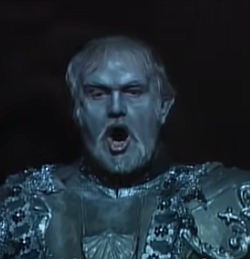Don Giovanni at San Diego Opera – good
Tasha Koontz presented the refined steel of the character set upon vengeance.
The San Diego Opera performance of Mozart’s Don Giovanni on Sunday, February 4, was good, overall. It definitely wasn’t bad but it wasn’t great. It was good. The singing was good to pretty good. None of it was bad and some of it was great. The production was not good and some of it was awful.
In the title role, baritone Germán E Alcántara was good but didn’t quite have the vocal maturity to pull the role off. I would imagine that 10 years hence, Mr. Alcántara could present a formidable Giovanni. At times, in this performance, he resorted to dramatic shouting which could have been effective.
Giovanni’s partner in crime, Leporello, was performed by baritone Ethan Vincent. Mr. Vincent was the most accomplished singer in the cast. When Mr. Vincent came on stage at the start of the show, bari-hunk arms on display, he smashed a beer can and tossed it off stage. This was to be a more menacing Leporello and I quite liked that. However, the menace soon decayed. The character wasn’t helped by a random sniveling tone that was supposed to be comical. However, Mr. Vincent does have a refined baritone voice that was present and consistent.
Mezzo-soprano Megan Moore was good in the role of Donna Elvira, the long-suffering jilted lover of Giovanni. Her singing was pretty but lacked some of the fire I associate with the role. As an emerging artist, she promises to be a singer to keep an eye on.
In the role of Donna Anna, Tasha Koontz was excellent. Her voice filled the cavernous Civic Theatre but remained beautiful. She executed some impressive messa di voce effects that helped to highlight the character’s sweetness. Yet, when the time was right, she presented the refined steel of the character set upon vengeance.
The most impressive singer was tenor Alex McKissick. His tone was even from top to bottom. He has taken the time and put in the effort to create depth in his singing and his two arias were spectacular testaments to his vocal abilities.
An opera production needs to make a choice. Is it going to be representational or abstract? It can be one or the other but not both unless a confused mess is the goal. This Don Giovanni switched between the two from scene to scene and sometimes mid-scene.
The main production elements were stock images and video projected on a screen that was miles upstage and looked to be designed for a stage half the size of the Civic. Between the singers and the screen were conductor Yves Abel and the orchestra who were excellent. The issue was that the singers were downstage of the conductor and could only see him via video monitors. The ensemble at the end of Act I suffered from not having direct contact with the conductor.
The final scene replaced the food from dinner with Scarface piles of cocaine. Cocaine made a brief appearance earlier in the show when Leporello took a bump but suddenly Giovanni went full-on snowman. This would have made sense if Giovanni and Leporello had been dealing for the entirety of the show but they did not. I have no problem with Giovanni getting down with that zaza but it can’t just appear out of nowhere.
A sensible Don Giovanni:
